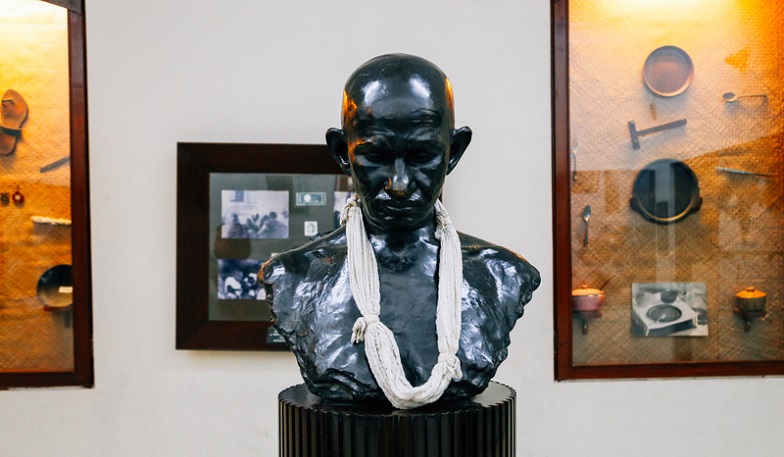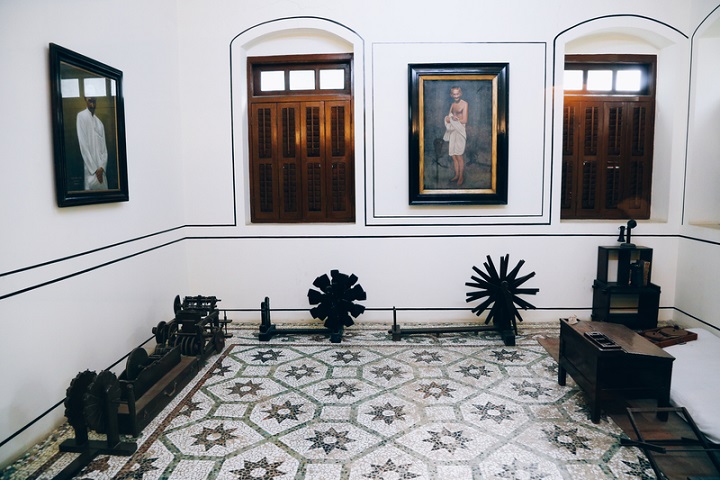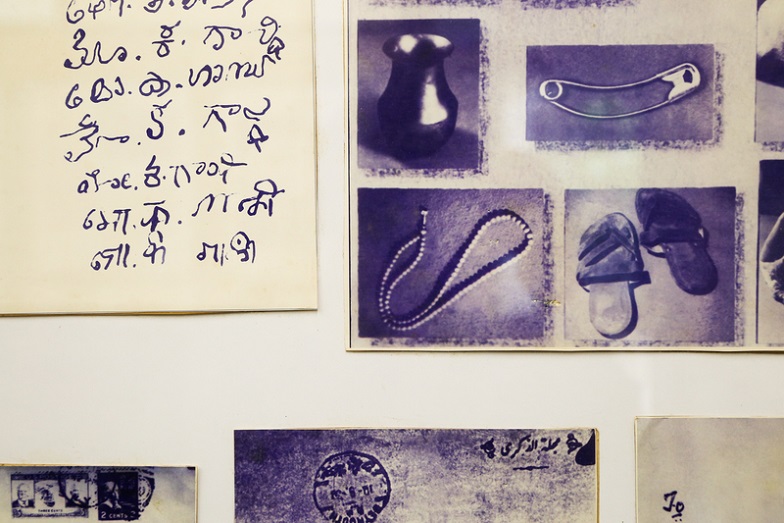
Mani Bhavan Gandhi Sangrahalaya is a museum located in the city of Mumbai, India. It is a historic building once the residence of Mahatma Gandhi, who lived there from 1917 to 1934. The museum showcases the life and teachings of Mahatma Gandhi and his role in India’s struggle for independence.
Let us explore the history of Mani Bhavan, its significance in India’s history, and its importance as a cultural and educational institution.
History of Mani Bhavan Gandhi Sangrahalaya
Mani Bhavan was initially built as a two-story building in 1917 by Revashankar Jagjeevan Jhaveri, a friend, and follower of Mahatma Gandhi. At the time, Gandhi was living in Ahmedabad and looking for a place to stay during his frequent visits to Mumbai. Jhaveri offered him the use of his house, and Gandhi stayed there on and off for several years.
In 1932, when Gandhi was imprisoned for his role in the Civil Disobedience Movement, he wrote a letter to Jhaveri asking him to turn Mani Bhavan into a center for promoting Indian nationalism. Jhaveri agreed, and the building was converted into a meeting place and headquarters for the Indian National Congress, the political party that Gandhi led in the struggle for independence.
After India gained independence in 1947, Mani Bhavan became a memorial to Gandhi’s life and work. In 1955, it was donated to the Gandhi Smarak Nidhi, a trust that was set up to preserve and promote Gandhi’s legacy.
Significance of Mani Bhavan Gandhi Sangrahalaya
Mani Bhavan is significant for several reasons. Firstly, it was the center of Gandhi’s activities in Mumbai for many years. He used the building as his base during his visits to the city, and it was a hub for meetings and discussions with other leaders of the independence movement. The building also served as a residence for Gandhi’s wife, Kasturba Gandhi, who played an essential role in the struggle for independence in her own right.
Secondly, Mani Bhavan is a symbol of Gandhi’s commitment to nonviolence and civil disobedience as a means of achieving social and political change. Gandhi’s philosophy of nonviolence was central to his approach to politics, and he used it to challenge British colonial rule in India. Mani Bhavan was one of the places where he developed and refined his ideas on nonviolence, and it was from here he launched some of his most important campaigns, including the Salt Satyagraha.
Finally, Mani Bhavan is an important cultural and educational institution in India. The museum attracts thousands of visitors annually, including school groups, tourists, and scholars. It provides valuable insight into Gandhi’s life and teachings and helps to promote his ideas of peace, tolerance, and social justice. The museum also hosts various events and activities, including talks, seminars, and cultural performances, that help engage the local community and promote the values that Gandhi stood for.

The Museum at Mani Bhavan Gandhi Sangrahalaya
The museum at Mani Bhavan is dedicated to the life and work of Mahatma Gandhi. It houses a collection of photographs, documents, and artifacts that trace Gandhi’s journey from his childhood in Gujarat to his role in India’s struggle for independence. The museum is divided into several sections, each focusing on a different aspect of Gandhi’s life and teachings.
The museum’s first section is devoted to Gandhi’s early life and education. It contains photographs and documents that shed light on Gandhi’s family background, schooling, and early career as a lawyer in South Africa. The exhibit showcases the racism and discrimination that Gandhi encountered in South Africa, which profoundly impacted his political and social views.
The second section of the museum covers Gandhi’s role in India’s independence movement. It includes exhibits on some of Gandhi’s most important campaigns, including the Salt Satyagraha, the Non-Cooperation Movement, and the Quit India Movement. The displays show how Gandhi used nonviolence and civil disobedience to challenge British rule in India and how he inspired millions of people to join the struggle for independence.
The third section of the museum focuses on Gandhi’s philosophy of nonviolence and his vision for a free and independent India. It includes displays of Gandhi’s ideas on swaraj (self-rule), ahimsa (nonviolence), satyagraha (civil disobedience), and Sarvodaya (universal upliftment).
The exhibits also highlight Gandhi’s views on social justice, human rights, and religious tolerance and his early career as a lawyer in South Africa. The exhibition showcases the racism and discrimination that Gandhi encountered in South Africa, which profoundly impacted his political and social views.
The second section of the museum covers Gandhi’s role in India’s independence movement. It includes exhibits on some of Gandhi’s most important campaigns, including the Salt Satyagraha, the Non-Cooperation Movement, and the Quit India Movement. The exhibits show how Gandhi used nonviolence and civil disobedience to challenge British rule in India and how he inspired millions of people to join the struggle for independence.
The third section of the museum focuses on Gandhi’s philosophy of nonviolence and his vision for a free and independent India. It includes displays of Gandhi’s ideas on swaraj (self-rule), ahimsa (nonviolence), satyagraha (civil disobedience), and Sarvodaya (universal upliftment). The exhibits also highlight Gandhi’s views on social justice, human rights, and religious tolerance.
The museum also houses a library with many books and publications on Gandhi and his philosophy. The library is open to the public and provides a valuable resource for scholars, researchers, and students.
The museum also houses a library with many books and publications on Gandhi and his philosophy. The library is open to the public and provides a valuable resource for scholars, researchers, and students.
Visiting Mani Bhavan Gandhi Sangrahalaya
Mani Bhavan Gandhi Sangrahalaya is located in the Gamdevi area of Mumbai and is easily accessible by public transportation. The museum is open daily from 9:30 am to 5:30 pm, except on Mondays and public holidays. Admission to the museum is free, although donations are welcome.
Visitors to the museum can take a guided tour, which is available in several languages, including English, Hindi, and Marathi. The time provides a detailed overview of Gandhi’s life and work and helps visitors understand Mani Bhavan’s significance in India’s history.
In addition to the museum exhibits, Mani Bhavan also hosts a range of events and activities throughout the year. These include talks, seminars, and cultural performances promoting Gandhi’s peace, tolerance, and social justice ideas. The museum also has a gift shop that sells books, postcards, and souvenirs related to Gandhi and his legacy.
Timing to Visit and Entry Fee
Mani Bhavan Gandhi Sangrahalaya is open daily, except on Mondays and public holidays, from 9:30 am to 5:30 pm. The museum is a popular tourist attraction that can get crowded during peak hours. To avoid crowds and long lines, visiting the museum in the morning or during the week when there are fewer visitors is best.
Additionally, if you want to take a guided tour, arriving early in the day is best, as terms tend to fill up quickly. Overall, the best time to visit the museum is during the off-peak season, from June to September, when the weather is more relaxed and fewer tourists in Mumbai.

Mani Bhavan Gandhi Sangrahalaya
- Address:19 Laburnum Road, Gamdevi, Mumbai – 400 007 INDIA.
- Tel. No. :+91 22 2380 5864
- Email: manibhavan@gmail.com and info@gandhi-manibhavan.org
- Museum Entry Fees: Rs. 20 per person and Rs. 10 for students
- Working Hours are from 9.30 a.m. to 6.00 p.m. on all days
- Working Hours – The Library is open all weekdays, from 9.30 am to 6.00 pm.
It is closed on the 2nd and 4th Saturdays and public holidays.
How To Reach Mani Bhavan
Mani Bhavan Gandhi Sangrahalaya is located in the Gamdevi area of Mumbai and is easily accessible by public transportation. Here are some of the ways to reach the museum:
- By Taxi: Taxis are a convenient way to reach the museum and are available throughout the city. You can tell the driver to take you to Mani Bhavan in Gamdevi, and they will know where to go. The approximate travel time from the city center to the museum is 20-30 minutes, depending on traffic.
- OLA / Uber – You can book a private cab service using the OLA or Uber app on your smartphone.
- By Bus: Several bus routes connect Mani Bhavan to different parts of Mumbai. You can take a bus from any of the major bus stops in the city, such as Churchgate, CST, or Dadar, and get off at the Gamdevi bus stop, which is located near the museum.
- By Train: The closest railway station to Mani Bhavan is the Grant Road railway station on the Western Line of the Mumbai Suburban Railway. You can take a taxi or auto-rickshaw from the station to reach the museum, which is about 2 kilometers away.
Overall, Mani Bhavan is easily accessible by public transportation, and there are several options to choose from depending on your location and preferences.
Other Places to visit near Mani Bhavan
Several other places to visit near Mani Bhavan Gandhi Sangrahalaya offer a glimpse into Mumbai’s rich cultural and historical heritage. Here are some of the top attractions that you can explore:
- Gateway of India: Located just 5 kilometers from Mani Bhavan, the Gateway of India is one of Mumbai’s most iconic landmarks. Built in 1924, this majestic arch stood at the entrance of Mumbai’s harbor and was originally built to commemorate the visit of King George V and Queen Mary to India.
- Chhatrapati Shivaji Terminus: Formerly known as Victoria Terminus, this historic railway station is located about 6 kilometers away from Mani Bhavan. Built in 1887, the station is a UNESCO World Heritage site known for its Victorian Gothic architecture and stunning stained-glass windows.
- Marine Drive: Located about 7 kilometers from Mani Bhavan, Marine Drive is a famous promenade stretching along the Arabian Sea. Also known as the Queen’s Necklace, the promenade is lined with palm trees and offers stunning sea views.
- Prince of Wales Museum: Located about 7 kilometers from Mani Bhavan, the Prince of Wales Museum is one of Mumbai’s top cultural institutions. The museum houses a vast collection of art, artifacts, and exhibits that showcase India’s rich cultural heritage.
- Hanging Gardens: Located about 8 kilometers from Mani Bhavan, the Hanging Gardens is a popular park known for its lush greenery and scenic city views. The park is on top of Malabar Hill and offers panoramic views of the Arabian Sea.
These are just a few of the many attractions that you can explore near Mani Bhavan Gandhi Sangrahalaya. With so much to see and do in Mumbai, you can easily spend several days exploring the city and soaking up its rich cultural and historical heritage.

Visiting Mani Bhavan Gandhi Sangrahalaya
Mani Bhavan Gandhi Sangrahalaya is located in the Gamdevi area of Mumbai and is easily accessible by public transportation. The museum is open daily from 9:30 am to 5:30 pm, except on Mondays and public holidays. Admission to the museum is free, although donations are welcome.
Visitors to the museum can take a guided tour, which is available in several languages, including English, Hindi, and Marathi. The tour provides a detailed overview of Gandhi’s life and work and helps visitors understand Mani Bhavan’s significance in India’s history.
In addition to the museum exhibits, Mani Bhavan also hosts a range of events and activities throughout the year. These include talks, seminars, and cultural performances promoting Gandhi’s peace, tolerance, and social justice ideas. The museum also has a gift shop that sells books, postcards, and souvenirs related to Gandhi and his legacy.
Conclusion
Mani Bhavan Gandhi Sangrahalaya is a cultural and educational institution dedicated to preserving Mahatma Gandhi’s legacy. The museum provides valuable insight into Gandhi’s life and teachings and helps to promote his ideas of nonviolence, civil disobedience, and social justice.
As one of the most influential figures in India’s history, Gandhi’s influence is still felt today, both in India and worldwide. Mani Bhavan is a fitting tribute to his life and work and a reminder of the enduring power of his message of peace and compassion.
Leave a Reply